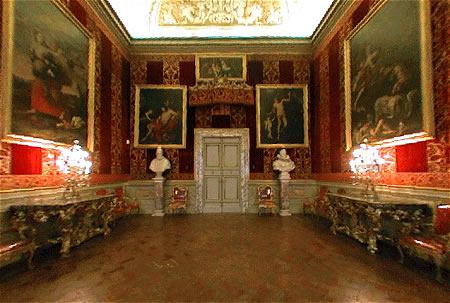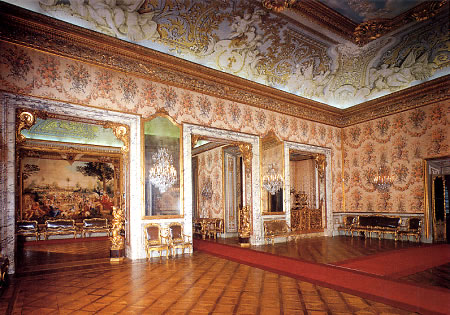|
|
 |
|
Galleria Doria Pamphili |
|
written
by Jennifer Lee / 07.12.2004 |
|
|
| |
Location |
| |
This art gallery and former home of Doria Pamphili is located on the Via del Corso. If you walk east or west along the main Corso Vittorio Emanuele II and turn North onto the Via del Corso, you will soon see signs behind black gates on the left (west) side of the street. The signs show the hours for the gallery and have a painting of a woman on the poster. Despite the official appearance that this entrance has, opening into a landscaped courtyard area, it is not the main entrance. Continue walking along the Via del Corso and turn left at the next street, following the left-pointing arrow that appears on a brown street sign indicating the direction of the Roman College. Walk along this street, traveling west, until you see the entrance on the left side of the street.
As a side note, I have also seen the name printed as Galleria Doria Pamphilj.
|
| |
|
| |
|
| |
Description |
| |
This location looks like a residential apartment building from the street but was once the opulent residence of Doria Pamphili, as explained in the audioguides available for free for students presenting their ISIC.
Inside you will find a lavish interior similar to that of the Villa Borghese. Every inch of the walls is covered with decoration, either marble, painting, or wood adornment.
The main attraction of this gallery is the sheer volume of paintings it houses. The diversity is immense, ranging from religious paintings featuring razor thin halos to still life portraits of dead animals. There are a good variety of sizes, styles and colors in the paintings. The ceiling paintings appear to extend the already vaulted ceilings further up, and the large windows bathe the gallery in natural light.
Try not to be distracted by the rooms that are closed; the open rooms provide plenty to see. The hallways between galleries are also lined with dozens of portraits, still life compositions, and religious depictions. If your patience and attention span last, look for the large room near the end of the gallery featuring several sculptures and busts.
I visited this museum in the afternoon around 2pm after a field trip and the gallery only had a handful of people inside. There were virtually no tourist type people there, and those that were present sat and admired single paintings for a long period of time. If you are a casual observer of art, plan to spend 30 minutes to an hour in the gallery. If particular paintings tend to capture your eye for longer periods of time, you may end up spending the whole afternoon.
Because the gallery was so empty in the middle of the afternoon, I believe any time of the day would be appropriate for visiting. The gallery hours are posted on the poster outside; it is open daily from 10am to 5pm and closed Thursday.
|
| |
|
| |
|
| |
Story of Discovery |
| |
I found this gallery when I happened to look inside the stately courtyard during one of my many journeys to the Roma store, which is also just off the Via del Corso. I first noticed the garden and parked car inside, and then saw the posters that were printed over the portrait of a young woman. Guessing that the building likely housed a type of art gallery, I wrote down the information and returned the next day to attend the exhibit.
|
| |
|
| |
|
| |
Element of Interest |
| |
This location captured my attention because it was different from other galleries and exhibitions throughout Rome that I have attended. Instead of various sculptures and busts with broken noses, it focuses on painting and houses the original art collection of the owner. The result of this is an abundance of portraits of family figures throughout the gallery and less religious depictions than commonly seen in most museums around Rome. The free audioguide is a good bonus for students, although I preferred to not use it when viewing the art.
I would call the attention of visitors to the number and variety of paintings because it rivals that of the Borghese Gallery in terms of artistic diversity. While the quality does not match that of Bernini’s famous sculptures or Raphael’s paintings in the Borghese, there are several charming small and large paintings that are worth seeing. The opening room alone, in which the tickets are sold, is covered in large paintings. In between wondering how two fragile braces can support such large canvasses, I admired the countryside that is so skillfully portrayed in many of the large landscape paintings.
|
| |
|
| |
|
| |
Image |
| |
| |

|
|
| Sala dei Velluti |
|
| |
|
| |

|
|
| Sala da Ballo |
|
| |
|
These two images show just two of several rooms in the gallery. The Sala dei Velluti has fewer paintings than most of the rooms, allowing the observer to concentrate on the two large paintings adorning opposite walls. While in some rooms the paintings are hung as many as possible with little pattern, this room is nicely symmetrical and aesthetically pleasing in its presentation. Most of the rooms will look like this when you visit because there are few other observers obscuring your view.
The second image shows the Sala da Ballo. This image shows the ornate decoration of the walls and ceiling. The exquisite furniture is also worth admiring, although some of it will be roped off to deter tired travelers from resting. The bright colors and natural lighting are particularly visible in this image. Many of the doorways are rectangular instead of arching, and open corridors are common. Most of the rooms are not divided by doors at all.
If you would like to see more images of the gallery or find more information, visit the gallery’s website at http://www.doriapamphilj.it/home.asp and learn the family’s story.
|
| |
|
| |
|
|
 |
|
